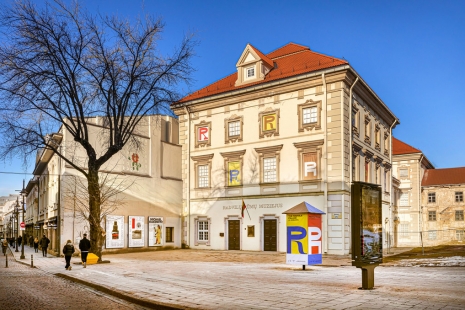The pieces are linked by the idea of an open field. The field is interpreted as a space unbound by stable limits, open to knowledge from an infinity of different perspectives, – says Audrius Novickas. – Due to them the field becomes a constantly emergent social, political theory, wherein individual and collective subjects engage in multifaceted and contradictory identity-building practices. These practices are never completely transparent, because the participation of subjects is impacted by the subconscious, by the supressed desires and differences. The fragmentations, instabilities, and the spatial forms related to them enable to observe, investigate and dramatize their misleading recognitions.’
Both works visit also the questions of identity, power, memory politics, the themes of importance in Novickas’ earlier work. To create his pieces, the artist employs the iconographic materials of different cities. In the installation the Pendulum it is used as a metaphor for social engineering. The Vitrine Morte emerges as a contemplative dedication to Vilnius, the artist’s native town.
Vilnius from transmuting observation perspectives
The film Vitrine Morte connects three narratives about transmuting observation perspectives of Vilnius.
‘The starting point of the first narrative is Vilnius pharmacy Swan (Pod Labędziem) owned by the family of the Polish singer and actor Marylia Rodowicz. For long years the pharmacy was distinguished by its iconic shop window porcelain swan. When the pharmacy was closed in the end of the 20th century, the swan was believed to have disappeared until one Vilnius optician displayed a similar decoration in their window. Many locals were convinced that it was the original swan in a different place, but several years ago an anonymous individual gifted the real pharmacy swan to a museum in Kaunas’, tells the story A. Novickas.
The second narrative in the film pictures Vilnius as a storage of cinema sets, where one can find a backdrop and a setting suitable to depict a variety of places of the world, including Vilnius, as a direction of global tourism where inspired-by-the-film tourists delve into the virtual time and space experiences in the real town. The third narrative is about a panoptic regime implemented by the electronic equipment and the AI programmes dispersed over Vilnius.
The reflection on contradictory forms of the knowledge of the world and social engineering in the installation the Pendulum
The work was inspired by an expedition organized in 1934 by the Italian statistician, demographer and eugenicist Prof. Corrado Gini. The participants of the expedition researched the Caraites (also,Karaietes) of Poland and Lithuania. The results of the anthropological research of the Caraites informed a discourse on the ethnic origins and the genetic character of this community. ‘In the context of the looming holocaust, the expedition could have influenced the decision on the preservation of the Caraites community. Probably it did, as the Caraites in Poland and Lithuania escaped a systemic persecution during WWII’, shares his thoughts the artist.
The installation is composed of a pendulum and a carpet. The carpet is also an enlarged holder for the instruments needed for an expedition. The patterns of the carpet are designed on the basis of the plans of ideal cities and the concentration and extermination camps of Paneriai, Auschwitz-Birkenau, Dachau, Sachsenhausen, Treblinka. The instrument of anthropometric and cartographic measurements serves as a fixed support for the pendulum wire. It seems to look for a place in the empty instrument holder, at the same time measuring the distances and differences between the ideal cities and the concentration camps.
The patterns of the carpet are designed on the plans of the concentration and extermination camps of Paneriai, Auschwitz-Birkenau, Dachau, Sachsenhausen, Treblinka, and the plans of the realized and unrealized modern towns, Addis Ababa, Algiers, Brasilia and others.
Audrius Novickas‘solo exhibit The Field Folds opens 1 December 2023 at the Radvila Palace Museum of Art (Vilnius St 24, Vilnius) and will run through 3 March 2024.
Coordinator Viltė Visockaitė
Graphic designer Vytautas Volbekas
Project financed by: Lithuanian Council for Culture, Lithuanian Interdisciplinary Artists’ Association





